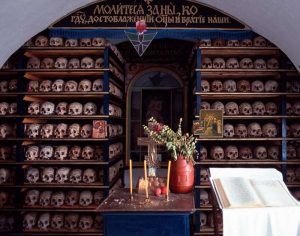Gleanings: Mt. Athos’ Unique Burial Practice
~ The following in an excerpt from an article in pravoslavie.ru
Now let’s take a look at the following scenario: a monk in one of the Athonite monasteries reposes in the Lord. In order to bury him, the brethren of the monastery have to urgently fulfill an extremely laborious obedience—prepare the place of burial for their deceased brother. Let us not forget that the deceased, according to monastic customs, are buried as soon as possible, usually on the very day of their death. Little by little, or rather, stone by the stone, the hardworking monks, with their shovels ringing, dig through the rough terrain of Mt. Athos. Finally, the grave is complete and the body of the deceased brother is gently placed within. But now what? Will they really fill the grave back up with all those stones and boulders they just dug up?! For a cause such as this they do manage to find enough soil. Now let us again keep in mind the deficit of soil on Mt. Athos…With the grave now covered and topped off with a small mound of earth, and the wooden cross with its inscription mounted in place, the burial is complete…

For the first 40 days, the entire brotherhood of the monastery reads the customary prayer rule for the reposed, repeating it according to the amount of knots on their prayer ropes. Also, in memory of the reposed monk, the monastery prepares “kolivo” (also called “kutia” in Russia), a ritual memorial dish which consists of some grain such as wheat, rye, oat, or rice, as well as honey, raisins and nuts. Furthermore, for the following three years the deceased is commemorated at every Liturgy during the proskomedia. Now bearing in mind that the Divine Liturgy in the monasteries is served daily, this means that the deceased monk receives commemoration every day and for quite a long time. Finally, the name of the deceased is also recorded in a special memorial monastery book, the so-called “Kuvaras”…
After three years have passed, the grave of the newly-reposed monk is carefully dug up and the brethren now examine the remains of the deceased to see what state they are in. If the soft tissues of the body are not completely decomposed yet, the grave will be covered up in likewise manner and the following procedure will be repeated again until it is clear that only the bones remain. By the way, according to Athonite tradition, a body that is not “accepted by the earth”, i.e., doesn’t decompose, is regarded as a sign that the monk did not make the effort to lead a proper monastic way of life and that his soul has not found rest in Heaven. In such case, the entire brotherhood begins to pray even more diligently, beseeching the Lord for the forgiveness of sins and purification of their fellow brother’s soul.
If the bones of the deceased are completely free from flesh (and this, under the Athos climate, while also taking into account the terrain, occurs most often in just about three years), they are taken out of the grave, and after being thoroughly washed with water and wine are transferred to the ossuary, which is a building that resembles a chapel and is usually located somewhere nearby, outside the walls of the monastery. As for the empty grave, it’s now ready to grant rest for another three years to someone else after his repose.